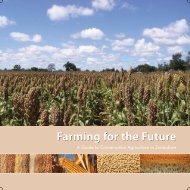Restoring the Soil - Canadian Foodgrains Bank
Restoring the Soil - Canadian Foodgrains Bank
Restoring the Soil - Canadian Foodgrains Bank
You also want an ePaper? Increase the reach of your titles
YUMPU automatically turns print PDFs into web optimized ePapers that Google loves.
74Green Manure/Cover Crop SystemsS81. Rice/azolla. Azolla is an algae thatgrows in rice paddy water and fixes up to30 kg of nitrogen per hectare. It can bespread from paddy to paddy to fertilize<strong>the</strong> rice virtually for free.44. Indonesia. Cowpeas and o<strong>the</strong>r edible gm/cc species often grow well on paddy fields duringseasons when <strong>the</strong>re is not enough water in <strong>the</strong>rivers to irrigate paddy rice.S82. Various crops/tephrosia. Tephrosiavogelii is planted as a contour barrier inmountainous areas to recuperate wastelands.This is done in various provinces ofnor<strong>the</strong>rn Vietnam, especially Son La andThai Nguyen Provinces. Hundreds orthousands of farmers use this introducedsystem.S83. Various crops/yam bean. Yam bean (Pachyrhizus erosus) is used in sou<strong>the</strong>rnVietnam, both as a gm/cc in rotation with o<strong>the</strong>r crops, and as a home-made insecticide.This traditional system is practiced widely by an unknown number of farmers.S84. Various crops/soybeans. Throughout Vietnam, soybeans (Glycine max) arerotated with o<strong>the</strong>r crops to improve soil fertility and to produce a valued food.Hundreds of thousands (if not millions) of farmers use this traditional system.S85. Maize/mungbeans. Mungbeans are intercropped in maize fields in nor<strong>the</strong>rnVietnam. Both crops are planted at <strong>the</strong> same time. Thousands of farmers use thistraditional system.S86. Several crops/jackbean. The jackbean is occasionally grown on wastelands inYen Bai Province to recuperate <strong>the</strong> areas for <strong>the</strong> cultivation of many o<strong>the</strong>r crops.Jackbean seeds are broadcast on <strong>the</strong> land a week or so before <strong>the</strong> beginning of <strong>the</strong>rainy season, at about two or three seeds/square metre. Where weeds are particularlyaggressive, you may need to cut <strong>the</strong> weeds back once, in order to allow <strong>the</strong> jackbean togrow vigorously. In such cases, planting <strong>the</strong> seeds (placing <strong>the</strong>m about two cm under<strong>the</strong> soil surface) might also solve <strong>the</strong> problem, because planted seeds will germinateabout two weeks sooner than if <strong>the</strong>y are broadcast. The number of farmers who usethis traditional technology is probably well into <strong>the</strong> thousands.S87. Several crops/Indigophera spp. Indigophera trees are used like <strong>the</strong> jackbeanin S86, except <strong>the</strong> tree is usually used where farmers expect to spend several yearsrecuperating <strong>the</strong> wasteland. Again, <strong>the</strong> number of farmers who use this traditionaltechnology is probably in <strong>the</strong> thousands.S88. Cassava/rice bean. Bushy-type varieties of rice bean are intercropped with cassava.When <strong>the</strong> rice bean starts to compete with <strong>the</strong> cassava, <strong>the</strong> rice bean plants arepruned down to between 1 and 1.5 m in height, forcing <strong>the</strong> plant to grow laterallyra<strong>the</strong>r than vertically. Hundreds, if not thousands, of farmers use this traditional system.
















